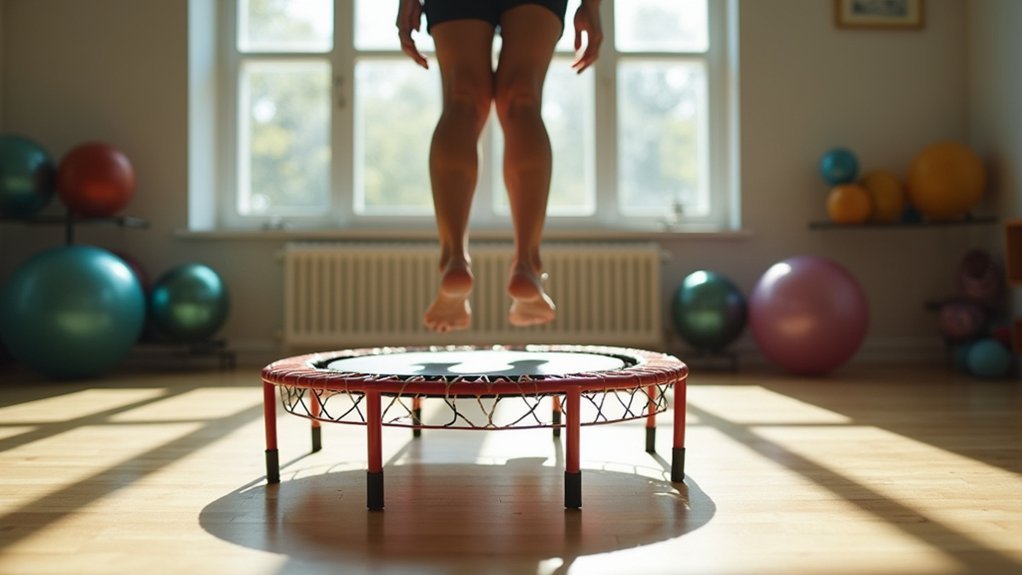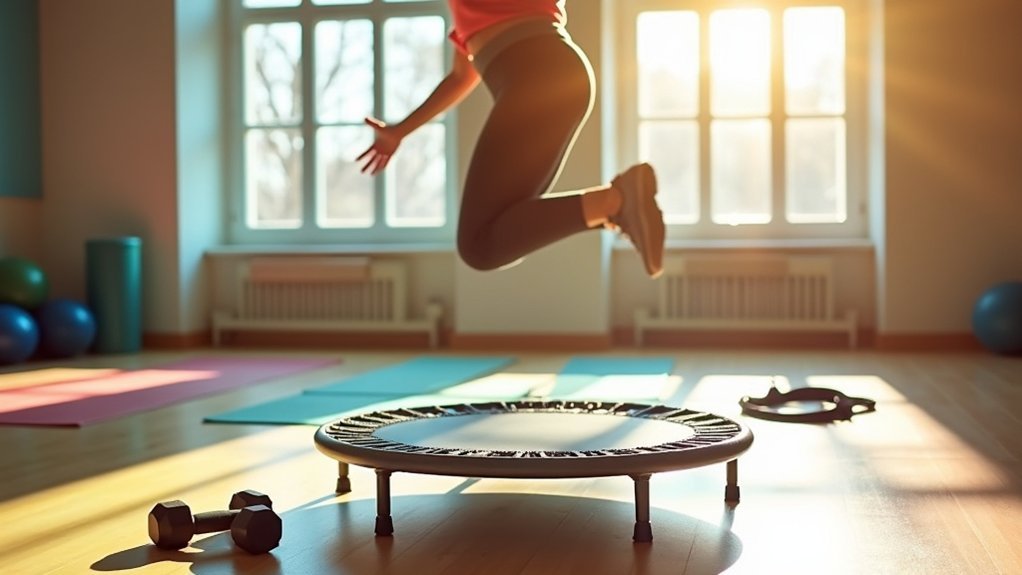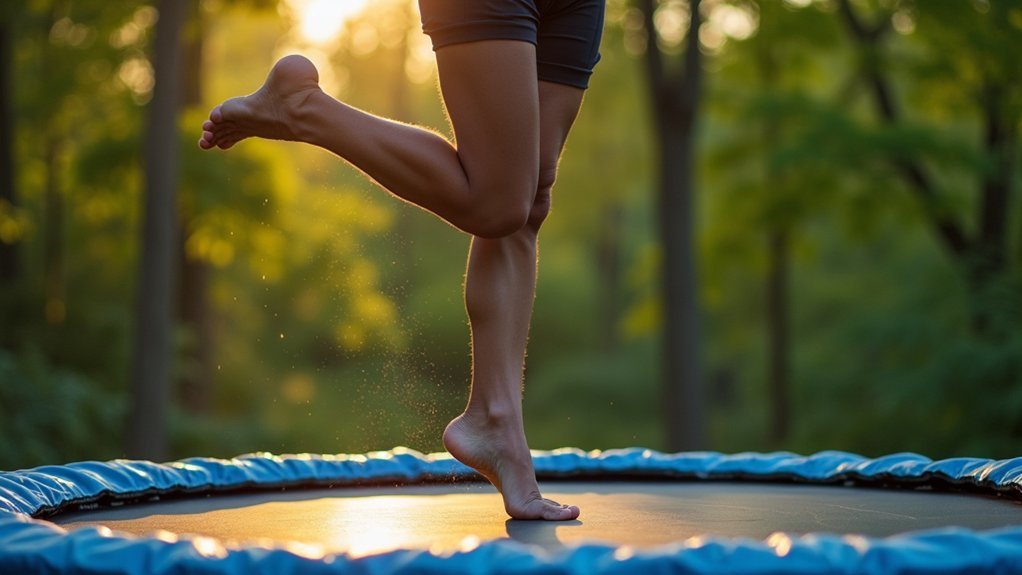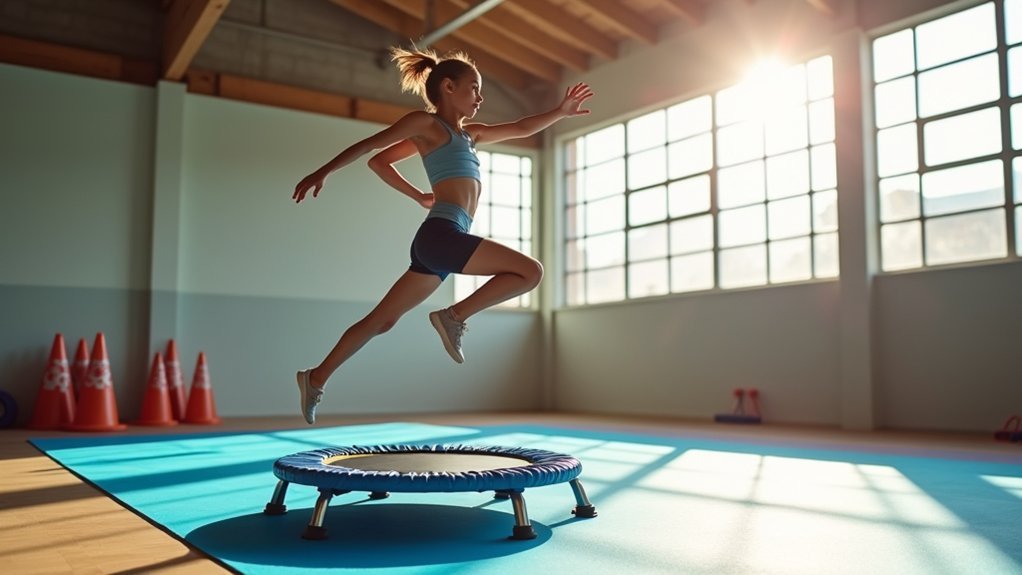Mini trampolines offer an effective way to improve your balance through proprioception training. As you bounce, your body makes continuous micro-adjustments, engaging joint stabilizers and enhancing spatial awareness. Start with gentle exercises like heel bounces and marching movements before progressing to advanced drills like single-leg hops and directional changes. Regular sessions can lead to measurable balance improvements for all ages and fitness levels. Discover how this low-impact approach can transform your stability in just weeks.
The Science Behind Proprioception and Balance

While many fitness enthusiasts focus solely on strength or cardio benefits, proprioception forms the foundation of effective movement and balance. Your body’s ability to sense its position in space drives coordination and stability during every movement you make.
When you jump on a mini trampoline, your proprioceptive system engages intensely as sensory receptors in your muscles, tendons, and joints constantly adjust to the unstable surface. This information travels to your central nervous system, which makes split-second adjustments to maintain balance.
This process strengthens the connection between your brain and muscles, improving both active and passive joint position sense. The result? Better postural stability, reduced injury risk, and enhanced athletic performance.
Your proprioceptive system fundamentally functions as your body’s internal GPS, becoming more accurate with each training session. The consistent practice on a mini trampoline may be particularly beneficial for those experiencing age-related proprioceptive deterioration, which naturally occurs as we get older.
Why Mini Trampolines Create Ideal Proprioceptive Challenges
Unlike traditional exercise platforms, mini trampolines provide an unparalleled environment for developing proprioception through controlled instability.
The dynamic surface forces your body to make constant micro-adjustments, engaging multiple joint stabilizers simultaneously while preventing compensatory muscle patterns.
Constant micro-adjustments on the trampoline activate joint stabilizers naturally, bypassing dysfunctional movement patterns your body typically defaults to.
When you bounce, you’re experiencing multi-directional loading that combines vertical, horizontal, and rotational forces. This triggers rapid shifts between eccentric and concentric muscle actions while enhancing your spatial awareness. These effects also provide important proprioceptive input that supports sensory processing and self-regulation goals.
What makes mini trampolines exceptional is their sensory integration demands. You’re synchronizing visual, vestibular and proprioceptive systems with each rebound.
The beauty lies in adaptability—you can easily modify challenge levels by adjusting bounce height or adding movement variations.
Your neuromuscular system responds with increased muscle spindle sensitivity and improved co-contraction patterns, ultimately developing automated stability responses for real-world applications.
Essential Equipment for Your Rebounding Journey

Selecting the right mini trampoline forms the foundation of an effective rebounding practice. When shopping for your rebounding companion, prioritize models with high-weight capacities like the Darchen (450 lbs) for stability during dynamic movements. The quality of the steel frame contributes significantly to the safety and longevity of your rebounder.
Choose between metal springs for responsiveness or bungee cords for joint protection and quieter workouts.
- Stability-focused setup – Look for trampolines with multiple sturdy legs and non-slip surfaces to prevent accidents during balance challenges.
- Safety accessories – Invest in padded spring covers and grip socks to protect yourself from pinch points and slippage.
- Storage-friendly design – Consider foldable models like the BCAN if you’ll need to store your equipment between sessions.
- Support features – Beginners should select models with optional handlebars for progressive balance training.
Beginner-Friendly Mini Trampoline Balance Exercises
Mastering balance on a mini trampoline begins with foundational techniques that build confidence and stability.
Start with the basic heel bounce, maintaining a micro-bend in your knees and engaged core. Focus on vertical stability rather than height.
Master the foundation first: gentle heel bounces with soft knees and active core create stability before height.
Progress to side-to-side taps, shifting your weight laterally while keeping your bounce controlled.
Try the in/out foot placement, alternating between feet together and hip-width apart to challenge your dynamic balance.
When you’re ready, incorporate marching movements by alternating knee lifts while maintaining your bounce rhythm.
Keep your gaze forward, not down, to enhance proprioceptive feedback.
If you feel unstable, return to the basic bounce and practice “stability stamping” by pressing your feet downward to activate your core and lower-body stabilizers.
For beginners, position your feet wider than hips with a slight knee bend to create a stable foundation for all rebounding exercises.
Advanced Proprioception Drills for Seasoned Rebounders

Once you’ve built a solid foundation with beginner balance exercises, it’s time to challenge your proprioceptive system with advanced rebounding techniques.
These drills develop multi-directional stability, neuromuscular control, and reactive strength—skills that transfer directly to athletic performance and injury prevention.
- Single-Leg Rotational Hops – Perform 90° or 180° turns while landing on one foot, challenging your brain to process spatial orientation mid-air.
- Reactive Directional Changes – Have a partner call out unexpected directions mid-bounce, forcing rapid neuromuscular reprogramming.
- Medicine Ball Catch-and-Throw – Integrate upper body challenges by catching and throwing a weighted ball during flight phases.
- Unstable Surface Integration – Place foam pads on your trampoline or combine with BOSU platforms for unpredictable landings. These drills significantly enhance sensorimotor function by integrating multiple sensory systems simultaneously during movement.
Tracking Your Balance Progress Over Time
To truly enhance your balance skills on a mini trampoline, you’ll need a systematic approach to measuring improvement over time. Start by setting SMART goals specific to your balance objectives, then leverage technology through balance-tracking apps or video analysis with depth sensors.
Schedule regular assessments using single-leg stance tests or balance boards to challenge your stability. Keep a reflection journal documenting your perceived improvements and challenges. Visualize your progress through charts or color-coded systems that highlight trends.
Consider joining group challenges or partnering with peers for external feedback on your form and stability. For more precise measurements, explore advanced metrics like biomechanical analysis to evaluate joint angles and movement patterns during your rebounds. Maintaining a consistent cadence for tracking your balance progress ensures you stay engaged with your improvement journey and can make timely adjustments to your training approach.
These structured tracking methods will transform vague feelings of improvement into concrete evidence of your progress.
Combining Strength Training With Rebounding Sessions
Strength training and mini trampoline workouts create a powerful synergy that amplifies the benefits of both exercise forms. The rebounder’s unstable surface forces your core to engage during weighted movements while providing low-impact recovery between strength segments.
For peak results:
- Start with 5-8 lb dumbbells for overhead presses during controlled bounces, focusing on maintaining shoulder stability as you press upward.
- Perform bent-over rows with a slight bounce to activate your posterior chain while strengthening your back.
- Try plié squats combined with lateral raises for simultaneous lower-body power and upper-body endurance.
- Incorporate rotational medicine ball chops during lateral jumps to develop core strength across multiple planes.
These combined exercises are especially effective at improving cardiovascular fitness while being gentle on your joints compared to traditional high-impact workouts.
Use a 20:40 work-to-rest ratio, pairing 20 seconds of strength moves with 40 seconds of active bouncing recovery.
Adapting Workouts for Seniors and Balance-Impaired Individuals
Mini trampoline workouts offer remarkable benefits for seniors and those with balance impairments, providing a safe yet effective exercise option when properly adapted.
Begin with seated bounces before progressing to health bounces with feet remaining on the mat. Use wall rails or stability bars for additional support during your initial sessions.
Start small and stay safe—seated bounces first, then gentle health bounces with proper support nearby.
Arched-leg trampolines provide essential stability, while 5-15 minute sessions prevent fatigue-related instability.
Introduce side-to-side weight shifts gradually to improve lateral stability, and don’t forget proper footwear on non-slip surfaces. Regular rebounding activities can strengthen multiple muscle groups, enhancing functional mobility in older adults.
The evidence is compelling—12-week rebounding programs demonstrate significant improvements in Berg Balance Scale scores and reduced fear of falling.
For advanced practice, incorporate dynamic reaching exercises during gentle bounces to simulate real-world balance challenges while strengthening your core.
The Cognitive Benefits of Unstable Surface Training
While most exercisers focus primarily on the physical benefits of mini trampoline workouts, the cognitive advantages of training on unstable surfaces deserve equal attention.
Your brain works overtime when you bounce, as the unstable surface demands 14% more cognitive resources than stable training. This heightened neural engagement strengthens your brain-body connection and enhances your ability to handle real-world challenges that require quick thinking and adaptation. The constant feedback from various sensory systems during unstable surface training activates sensory reweighting for maintaining balance.
- Multitasking mastery – Your brain learns to coordinate movement while processing environmental feedback
- Heightened proprioception – You’ll develop an enhanced awareness of your body’s position in space
- Improved decision-making – Bouncing trains reactive thinking as you constantly adjust to the shifting surface
- Enhanced attention – Your ability to focus improves as you navigate the cognitive-motor demands of the trampoline
Creating a Progressive 8-Week Balance Improvement Plan
Building on these impressive cognitive benefits, let’s explore how you can transform your balance abilities with a structured approach to mini trampoline training.
Your 8-week journey begins with foundational stability exercises in weeks 1-2, focusing on basic stances and controlled bouncing to develop familiarity.
By weeks 3-4, you’ll progress to more dynamic movements, incorporating side-to-side actions and single-leg work.
Weeks 5-6 challenge you with advanced techniques like closed-eye exercises and multi-directional jumps, while the final fortnight refines your skills for long-term maintenance.
Throughout the program, you’ll gradually increase difficulty while maintaining proper form to prevent injuries.
Track your progress using self-assessment tools and always prioritize safety with appropriate equipment and fall prevention strategies.
This structured approach aligns with evidence-based programs like A Matter of Balance that help older adults reduce their fear of falling.
Remember to bookend each session with thorough warm-ups and cool-downs.
Preventing Common Rebounding Injuries Through Proper Form
Your body alignment on the trampoline directly affects your safety, with proper posture reducing strain on your spine and joints during each bounce.
To protect your knees and ankles, keep them slightly bent when landing and never lock your joints at the height of your jump.
You’ll minimize impact forces by landing softly on the balls of your feet first, then rolling through to your heels while keeping your core engaged throughout the movement. Multiple jumpers significantly increase injury risk, so always limit trampoline use to one person at a time.
Alignment During Rebounds
Proper alignment forms the foundation of safe and effective mini trampoline workouts, preventing common injuries that can derail your fitness routine.
When you’re bouncing, your body needs to maintain specific positions to maximize benefits while minimizing risks.
To maintain ideal alignment during rebounding:
- Distribute your weight evenly across both feet, keeping them slightly wider than shoulder-width apart for a stable foundation.
- Bend your knees slightly to absorb shock upon landing, preventing jarring impacts on your joints.
- Engage your core muscles throughout each bounce, stabilizing your torso and protecting your spine.
- Maintain a slight forward hinge from your hips while keeping your back straight, creating the ideal posture for controlled, fluid movements.
Remember to press down through your heels rather than bouncing on your toes, as this activates hamstrings and promotes better stability during your workout.
Joint Protection Techniques
While alignment sets the stage for rebounding success, protecting your joints during these workouts deserves special attention. Land with slightly bent knees to absorb impact and reduce joint stress. High-quality mini trampolines offer superior shock absorption compared to larger models or hard surfaces.
Begin with gentle bounces and gradually increase intensity, allowing your knees to adapt without overexertion. Maintain controlled deceleration when landing to minimize force on your joints. For knee safety, focus on proper knee flexion throughout your rebounds. For individuals with hip arthritis, the pliable jumping surface provides significant joint stress reduction during exercise.
Before starting, warm up thoroughly to prevent muscle strains. If you have pre-existing joint issues, consult a healthcare professional first.
Wearing appropriate footwear improves stability, while regularly inspecting your trampoline for wear prevents accidents and guarantees continued joint protection during your rebounding routine.
Rebounding Case Studies: Real-World Balance Transformations
Beyond the theoretical benefits of mini trampoline workouts, real-world case studies provide compelling evidence of remarkable balance transformations.
Research consistently demonstrates that rebounding exercises deliver measurable improvements across diverse populations and conditions.
- Parkinson’s patients experiencing 42% better static balance after just eight weeks of regular rebounding sessions
- Overweight women showing significant improvements in both cognitive function and dynamic balance following mini trampoline programs, with noticeable enhancement in proprioceptive feedback occurring after six weeks of consistent practice
- Older adults increasing their walking distance by 15% and reducing fall risk following 12-week rebounding interventions
- Children with cerebral palsy developing enhanced postural control through structured rebounding therapy, with measurable improvements in daily functional activities
These documented cases confirm that you’ll experience tangible balance benefits from incorporating rebounding into your fitness routine.
Incorporating Mini Trampoline Training Into Your Weekly Fitness Routine
Integrating a mini trampoline into your fitness regimen requires thoughtful planning to maximize benefits while preventing injury.
Begin with 10-15 minute sessions 2-3 times weekly, focusing on low-impact movements like gentle knee lifts and heel taps. Use stability aids initially if needed.
Start small to build confidence—10-15 minute sessions with gentle movements will establish proper form while your body adapts.
As you progress, increase to 20-30 minute workouts 3-4 times weekly, incorporating intervals that alternate high-intensity jumps with rest periods. Add resistance bands during bounces for strength training benefits.
Prioritize safety by wearing non-slip footwear, maintaining proper posture with soft knees and an engaged core, and regularly inspecting your equipment. These precautions are essential since mini trampolines provide low-impact cardio while the trampoline mat absorbs over 80% of impact.
For added challenge, introduce dual-task movements like arm circles or directional changes to enhance coordination and spatial awareness. Customize intensity based on your fitness level and health goals.
Frequently Asked Questions
Can Rebounding Help With Specific Sports Performance?
Yes, rebounding can enhance your sports performance by improving cardiovascular endurance, strengthening muscles, enhancing balance, and providing low-impact training that reduces joint strain while accelerating recovery between intense training sessions.
How Do Mini Trampolines Compare to Balance Boards for Proprioception?
Mini trampolines provide dynamic, multi-directional feedback while you’re bouncing, whereas balance boards offer stationary instability. You’ll get neurological stimulation from both, but trampolines add cardio benefits that boards don’t provide.
Are There Weight Limits for Mini Trampolines?
Yes, mini trampolines have weight limits ranging from 60 to 330 pounds depending on the model. You’ll need to check your specific trampoline’s guidelines to guarantee safe use and prevent structural damage.
Can Children Safely Use Mini Trampolines for Balance Training?
Children can use mini trampolines for balance training with strict supervision. You’ll need to impose one-at-a-time use, prohibit flips, guarantee proper padding, and follow age guidelines (AAOS recommends none for under six).
How Does Rebounding Affect Those With Inner Ear Disorders?
Rebounding can help train your vestibular system and improve balance, but you’ll need to start gradually. If you have an inner ear disorder, you might experience dizziness initially until your body adapts.
In Summary
You’ve now accessed the powerful connection between mini trampolines and proprioceptive training. By consistently challenging your balance systems through rebounding, you’ll notice improvements in your everyday stability, athletic performance, and injury resistance. Start with simple exercises, progress gradually, and you’ll transform your balance capabilities. Remember, it’s not just about bouncing—it’s about building a stronger, more responsive body from the ground up.





Leave a Reply